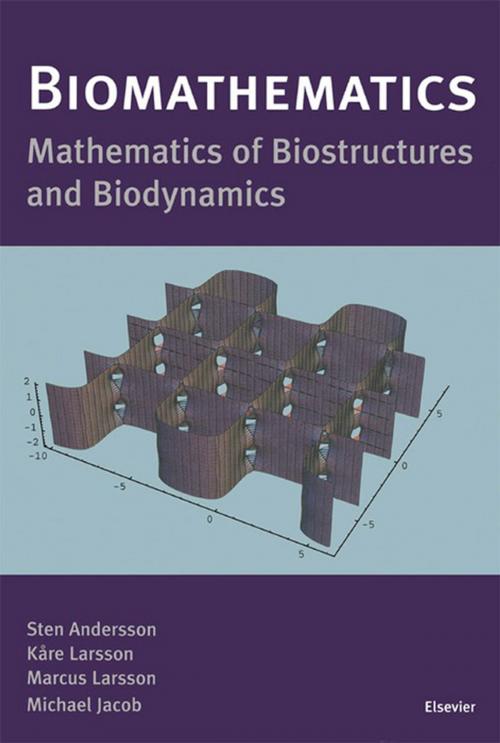Biomathematics
Mathematics of Biostructures and Biodynamics
Nonfiction, Science & Nature, Mathematics, Applied, Science| Author: | ISBN: | 9780080528076 | |
| Publisher: | Elsevier Science | Publication: | October 21, 1999 |
| Imprint: | Elsevier Science | Language: | English |
| Author: | |
| ISBN: | 9780080528076 |
| Publisher: | Elsevier Science |
| Publication: | October 21, 1999 |
| Imprint: | Elsevier Science |
| Language: | English |
This book presents new mathematics for the description of structure and dynamics in molecular and cellular biology. On an exponential scale it is possible to combine functions describing inner organisation, including finite periodicity, with functions for outside morphology into a complete definition of structure. This mathematics is particularly fruitful to apply at molecular and atomic distances. The structure descriptions can then be related to atomic and molecular forces and provide information on structural mechanisms. The calculations have been focussed on lipid membranes forming the surface layers of cell organelles. Calculated surfaces represent the mid-surface of the lipid bilayer. Membrane dynamics such as vesicle transport are described in this new language. Periodic membrane assemblies exhibit conformations based on the standing wave oscillations of the bilayer, considered to reflect the true dynamic nature of periodic membrane structures. As an illustration the structure of an endoplasmatic reticulum has been calculated. The transformation of such cell membrane assemblies into cubosomes seems to reflect a transition into vegetative states. The organisation of the lipid bilayer of nerve cells is analyzed, taking into account an earlier observed lipid bilayer phase transition associated with the depolarisation of the membrane. Evidence is given for a new structure of the alveolar surface, relating the mathematical surface defining the bilayer organisation to new experimental data. The surface layer is proposed to consist of a coherent phase, consisting of a lipid-protein bilayer curved according to a classical surface - the CLP surface. Without employing this new mathematics it would not be possible to give an analytical description of this structure and its deformation during the respiration cycle. In more general terms this mathematics is applied to the description of the structure and dynamic properties of motor proteins, cytoskeleton proteins, and RNA/DNA. On a macroscopic scale the motions of cilia, sperm and flagella are modelled.
This mathematical description of biological structure and dynamics, biomathematics, also provides significant new information in order to understand the mechanisms governing shape of living organisms.
This book presents new mathematics for the description of structure and dynamics in molecular and cellular biology. On an exponential scale it is possible to combine functions describing inner organisation, including finite periodicity, with functions for outside morphology into a complete definition of structure. This mathematics is particularly fruitful to apply at molecular and atomic distances. The structure descriptions can then be related to atomic and molecular forces and provide information on structural mechanisms. The calculations have been focussed on lipid membranes forming the surface layers of cell organelles. Calculated surfaces represent the mid-surface of the lipid bilayer. Membrane dynamics such as vesicle transport are described in this new language. Periodic membrane assemblies exhibit conformations based on the standing wave oscillations of the bilayer, considered to reflect the true dynamic nature of periodic membrane structures. As an illustration the structure of an endoplasmatic reticulum has been calculated. The transformation of such cell membrane assemblies into cubosomes seems to reflect a transition into vegetative states. The organisation of the lipid bilayer of nerve cells is analyzed, taking into account an earlier observed lipid bilayer phase transition associated with the depolarisation of the membrane. Evidence is given for a new structure of the alveolar surface, relating the mathematical surface defining the bilayer organisation to new experimental data. The surface layer is proposed to consist of a coherent phase, consisting of a lipid-protein bilayer curved according to a classical surface - the CLP surface. Without employing this new mathematics it would not be possible to give an analytical description of this structure and its deformation during the respiration cycle. In more general terms this mathematics is applied to the description of the structure and dynamic properties of motor proteins, cytoskeleton proteins, and RNA/DNA. On a macroscopic scale the motions of cilia, sperm and flagella are modelled.
This mathematical description of biological structure and dynamics, biomathematics, also provides significant new information in order to understand the mechanisms governing shape of living organisms.















